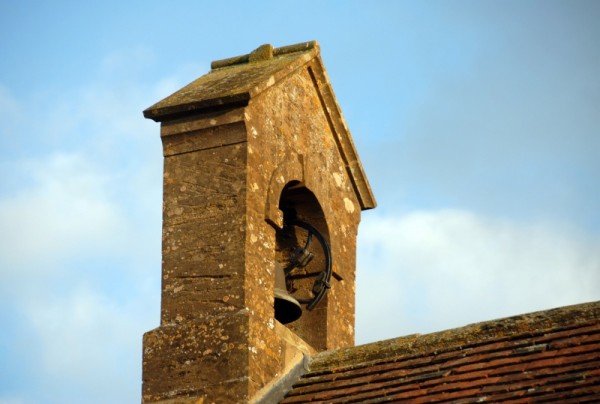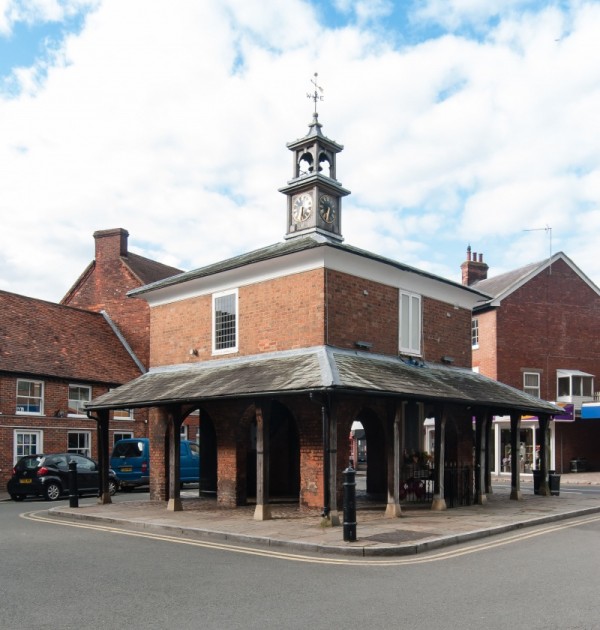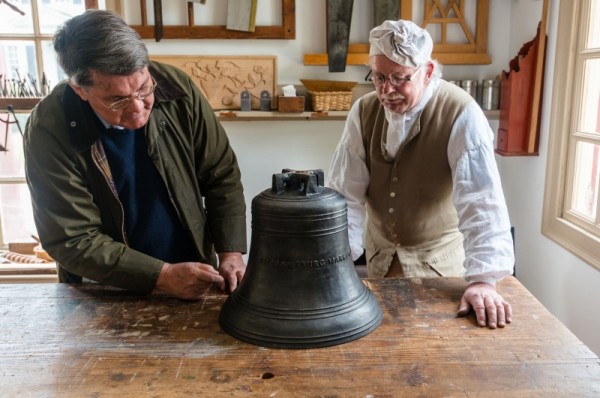Just imported from England, the Williamsburg market bell! Cast at an east London foundry in late February, the market bell is made of bell metal, a bronze alloy, and measures 16 ½ inches in diameter, 14 ¾ inches from the lip to the top the cannons, and weighs 119 pounds. It is tuned to C#. To make sure that future historians will not be confused as to its origins, the side of the bell is engraved in raised lettering “Williamsburg Market House” and “2015 Whitechapel” with a circular hallmark inscribed with the image of three bells. That hallmark belongs to the Whitechapel Bell Foundry Ltd., which has been in business since the 1570s.Over its long and distinguished history, the foundry has produced many famous bells such as Big Ben (13 ½ tons) in the

Elizabeth Tower at the Palace of Westminster as well as hundreds of church and market bells in the metropolis and throughout the country. In the eighteenth century, the firm shipped a number of bells to the American colonies including the Liberty Bell for the statehouse in Philadelphia and a peal of eight bells for the steeple of St. Michael’s Church, which still call parishioners to worship in the city of Charleston. Closer to home, the surviving bell at Bruton Church (26 inches in diameter, 21 inches in height, and approximately 450 pounds), a gift from merchant James Tarpley to the parish in 1761, is said to have been cast at the same foundry though no documents survive to confirm its origins. On seeing photographs of the Bruton bell, Whitechapel director Alan Hughes unhesitatingly claimed it as one of his, recognizing the similarities in the lettering and other features with bells of similar size and date manufactured by the London firm.
With the loss of Williamsburg’s corporate records during the Civil War, information about the manufacture, size, and placement of the original market bell disappeared.

Market House bell, Martock, Somerset, ca. 1750.
In most markets, bells sat in small turrets or cupolas atop the market house or occasionally on a post in the market place as in Fredericksburg in 1785. Imported European bells appeared in America by the late seventeenth century in places such as New York and Philadelphia. By the 1730s and 1740s, a small but steady supply of such bells appeared throughout the colonies. Unfortunately, contemporary records shed little light on the size of these market bells. In 1741 the corporation of New York ordered a good bell to be purchased from London of 200 pound weight, which may have been on the larger side compared to a number of eighteenth-century ones still found in English market houses, which suggest that smaller sized bells may have been more commonly used for markets.

Market House, Princes Risborough, Buckinghamshire, 1824.
Whatever their size, bells needed to be heard above the din of vehicular traffic and the voices of tradesmen setting up their stalls. Just as paving and bollards demarcated the formal boundaries of the market place, the sound of the bell announced its temporal dimensions. Around sunrise, the clerk of the market rang the bell to signal the opening of the market and later in the morning or early afternoon announced it close with another tug of the rope. In Alexandria in the early nineteenth century, a “small” bell was rung for a minute at the end of the market day, which was then followed by a “great bell” to indicate its termination. Most Americans are still familiar with this practice thanks to the opening and closing bells that still signal the opening and closing of trading on the New York stock exchange. The market bell marked precisely when the rules of the market applied with its prohibitions against forestalling, engrossing, and regrating. Without it, city officials would have been hard pressed to control the sharp practices that sometimes crept into the frenetic pace of market day.
Contributed by Carl Lounsbury, Architectural Historian.


Leave a Reply